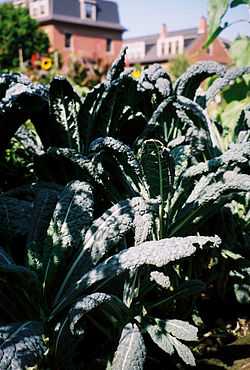Lacinato kale

Lacinato kale (called cavolo nero, literally "black kale", in Italian and often in English) is a variety of kale with a long tradition in Italian cuisine, especially that of Tuscany. It is also known as Tuscan kale, Tuscan cabbage, Italian kale, dinosaur kale, black kale, flat back cabbage, palm tree kale, or black Tuscan palm.[1][2] Lacinato kale has been grown in Tuscany for centuries,[3] and is one of the traditional ingredients of minestrone[4] and ribollita.
Description
Lacinato kale grows 2 to 3 feet tall[5] and has dark blue-green leaves with an "embossed texture"; its taste is described as "slightly sweeter and more delicate ... than curly kale."[6] The lacinato variety is sometimes called "dinosaur kale" because its bumpy leaves are said to resemble what dinosaur skin is thought to have looked like.[7] Because of its taste, "slightly bitter [and] earthy",[8] it has been called "the darling of the culinary world".[9]
Preparation and dishes
Lacinato kale, like most other kale varieties, is usually blanched first, and then sautéed with other, flavorful ingredients; in Campanian cuisine, anchovies are often added.[3] It is commonly used in pastas and soups, but can also be eaten raw, in a salad.[10]
In Tuscan cuisine, lacinato kale is often used in ribollita ("twice cooked"), a thick, hearty soup made up of ingredients cooked for a meal the day before.[11]
This kale is also used in other cuisines. In Montenegro and Croatia, it is known under the name raštan, raštika, or crno zelje (literally, black cabbage), and used as a side in winter dishes. In Dutch, it is called zwarte kool (black cabbage).
Cultivation
Lacinato kale dates to the 18th century in Italy.[12] This cultivar is popular among gardeners because of its color and texture,[12][13] and was listed amongst the plants Thomas Jefferson recorded in his 1777 garden at Monticello.[14] The plant grows to a height of two feet, with blistered leaves often over one foot in length each and two to four inches wide.[12] The "straplike"[15] leaves are typically harvested from the bottom of the stem, leaving the remainder of the plant looking like a palm tree.[12]
References
- ↑ Goin, Suzanne; Gelber, Teri (2005). Sunday Suppers at Lucques: Seasonal Recipes from Market to Table. Random House Digital, Inc. p. 236.
- ↑ Thorness, Bill (2009). Edible Heirlooms: Heritage Vegetables for the Maritime Garden. Skipstone. p. 90. ISBN 978-1-59485-142-1.
- ↑ 3.0 3.1 Appleman, Nate; Lindgren, Shelley; Leahy, Kate (2008). A16: Food + Wine. Random House. p. 230. ISBN 978-1-58008-907-4.
- ↑ Brennan, Georgeanna; Koons, Todd; Frankeny, Frankie (2003). Great Greens: Fresh, Flavorful, and Innovative Recipes. Chronicle. p. 30. ISBN 978-0-8118-3907-5.
- ↑ "Tuscan Kale - Dr. Weil's Garden".
- ↑ Murray, Michael T.; Pizzorno, Joseph; Pizzorno, Lara (2005). The Encyclopedia of Healing Foods. Simon and Schuster. p. 210. ISBN 978-0-7434-7402-3.
- ↑ "Lacinato Dinosaur Kale". Farmer D Organics. 2012-10-30. Retrieved 10 October 2012.
- ↑ Middleton, Susie; Fink, Ben (2010). Fast, Fresh, and Green: More Than 90 Delicious Recipes for Veggie Lovers. Chronicle. p. 166. ISBN 978-0-8118-6566-1.
- ↑ Soler, Ivette (2011). The Edible Front Yard: The Mow-Less, Grow-More Plan for a Beautiful, Bountiful Garden. Timber Press. p. 49. ISBN 978-1-60469-199-3.
- ↑ Ross, Jenny (2011). Raw Basics: Incorporating Raw Living Foods Into Your Diet Using Easy and Delicious Recipes. Hay House. p. 18. ISBN 978-1-4019-3166-7.
- ↑ Dickie, John (2008). Delizia!: The Epic History of the Italians and Their Food. Simon and Schuster. p. 285. ISBN 978-0-7432-7799-0.
- ↑ 12.0 12.1 12.2 12.3 Staub, Jack E.; Buchert, Ellen (2005). 75 Exciting Vegetables for Your Garden. Gibbs-Smith. p. 120. ISBN 978-1-58685-250-4.
- ↑ Ryrie, Charles (2003). The Country Garden. Reader's Digest. p. 111. ISBN 978-0-7621-0391-1.
- ↑ Jefferson, Thomas (2002) [1999]. Edwin Morris Betts, ed. Thomas Jefferson's Garden Book. Thomas Jefferson Memorial Foundation, UNC Press. p. 71. ISBN 978-1-882886-11-1. Retrieved June 1, 2011.
- ↑ McLaughlin, Chris (2010). The Complete Idiot's Guide to Heirloom Vegetables. Penguin. p. 139. ISBN 978-1-61564-052-2.
External links
- Gianni's Tuscan Black Kale recipe (includes video)
- Kale on WH Foods